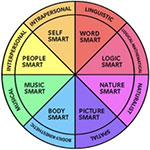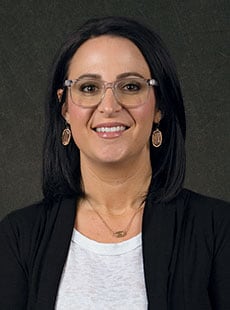 Course Introduction
Course Introduction
Core Standards of the Course
Strand 1
Students will identify and/or demonstrate Developmentally Appropriate Practices (DAP).
Standard 1
Identify developmentally appropriate (DAP) activities for young children.
-
Define developmentally appropriate practices (DAP)
- NAEYC- National Association for the Education of Young Children
- Developmentally appropriate practice is designed to meet children "where they are, both as individuals and as part of a group"
- 3 Core Considerations of DAP
- Knowing about child development and learning
- Knowing what is individually appropriate
- Knowing what is culturally appropriate
- See naeyc.org for more information
- Other DAP considerations
- Concrete- children learn through hands on activities, trial and error, and sensory input
- Age appropriate- a predictable sequence of stages (milestones) are uses as a guideline
- Individually appropriate- teachers use observations, evaluations and the individual needs and interests of the child to influence activities
- Culturally appropriate- teachers are aware and support a community of learners that is multicultural, nonsexist and differing abilities
- Flexible- children have free choice to move freely between activities, they are given time to explore
- Real, relevant and relatable- activities and lessons have an impact on a child's life and they can connect
- Intentional teaching- play with a purpose
- Language- high quality learning environments encourage children to ask questions, discuss ideas and add comments
- Social Development Theory, Lev Vygotsky
- Social learning and cognitive development are intertwined
- Zone of Proximal Development- this is the distance between a child's ability to attain a skill with guidance and the child's ability to solve the problem independently.
- Scaffolding- guiding the child to support their learning, adults support learning through clues, modeling, promoting curiosity, or creating active experiences to stretch the child's skill
- Types of learning
- Child-directed or Child-initiated- a child decides what to do, the idea and the materials to use, the adult supports learning by following their lead
- Teacher directed- a teacher decides what to do and how to do it (i.e. circle time, teaching a new game, teacher directed steps, routines, etc.)
- Learning Styles
- Theory of Multiple Intelligences, Howard Gardner

- Theory of Multiple Intelligences, Howard Gardner
- Active vs. passive learning
- Active learning- being actively involved and engaged in the learning by doing, seeing and thinking; it is hands-on and active
- Passive learning- sitting and listening without interaction with others, the instructor or manipulative objects (ex. puppet show)
- Positive questioning techniques
- Open-ended questions- asking questions that require more than a yes or no answer, this is the ideal. Use the 5 W's (who, what, where, when, why and how) to begin a question so children can answer with more description.
- Close-ended questions- questions that require only a "yes" or "no" response. These limit or end conversations, discussions and learning. Not an effective method unless it is followed by an open-ended question.
- NAEYC- National Association for the Education of Young Children
Standard 2
Interpret positive guidance techniques for preschoolers.
-
Review guidance, discipline, and punishment
- Guidance: continual long-term influence on behavior. The act or function of guiding through example, words, and actions. Giving advice or counseling. Helping, teaching, showing. Can be positive or negative
- Discipline: Behavior modification when needed; to teach and train a behavior by instruction and exercise in accordance with rules and conduct.
- Discipline should be firm, fair and friendly.
- Punishment: A penalty inflicted for wrongdoing, a crime or offense. Physical or verbal attacks. Might teach obedience to authority (out of fear), but not self-control, which enhances self-respect. May restrain a child temporarily, but it does not teach self-discipline. Demeans the child and negatively affects the relationship
- Distinguish between punishment and discipline/guidance techniques
- Self-discipline is the overall goal of guidance and discipline. The ability for the child or person to direct their own behavior and not to be directed upon
- Children may rebel when parents punish rather than discipline
- Adults who do not reinforce appropriate behavior may have children who resort to problem behavior
- Guiding by example is a very effective way to teach children the desired behavior
- Children feel more secure when caregivers are consistent.
- Positive guidance works when based upon consistency
- Children often misbehave for attention, so the caregiver should withdraw from the conflict and resolve the problem later. Attention is powerful reinforcement of positive and negative behavior
- Respond to aggressive behavior in nonaggressive ways. i.e.: When responding to a 2-year-old having a temper tantrum, if the caregiver remains calm and nonaggressive, then the situation becomes deescalated and can be resolved quicker. If the child is going to harm themselves or someone else remove them from the situation
- Adjust the environment so that items that might be a potential problem are placed out of sight
-
Identify common reasons children misbehave.
-
Discuss reasons and guidelines for setting limits
- Setting limits with kids means setting a guideline for behavior, even when there's not an official household rule. Limits should benefit the child
- State your limits clearly and firmly, discuss limits in advance, use consequences as a form of discipline when rules are broken, give your child explanations for your limits and then listen to what they have to say about it, etc.
-
Compare natural and logical consequences.
- Natural Consequences - occur without interference by letting nature just take its course. The child can see the result of his behavior/choices. This consequence can't be used if it will cause harm to the child, other's property, if the consequences are too far in the future, or if the behavior cannot be tolerated
- Logical Consequences - occurs with interference from the caregiver and should be relevant to the misbehavior. It should be short, not imposed in anger, and provide opportunities for the child to learn from their behavior and/or decision
-
Discuss guidelines for using positive guidance techniques
- Positive statements
- Clearly stating what the child IS expected to do instead of TELLING THEM WHAT NOT TO DO. i.e.: "Walk in the house" vs. "Don't run in the house."
- When giving directions, get down on the child's eye level to talk with them
- To encourage a child to complete a task, tell them what needs to be done in short and simple steps (2 or 3 max) and then go and help them get started
- Redirection
- Substituting unacceptable or dangerous behavior for acceptable behavior by helping the child to pay attention to or focus on something else that is equally or more appealing
- Children up to two years old can easily be distracted to change their behavior like playing with a toy instead of the electrical outlet
- Some behaviors just need to be redirected to an appropriate place such as having a child jump on a trampoline instead of on the bed
- Reverse attention
- Attention is a powerful reinforcement to guide children in a positive or negative direction
- Ignore the negative behavior when possible and reinforce the positive behavior
- Positive reinforcement
- Positive reinforcement is a great motivator and modifies behavior
- Limited choices
- Give children opportunities to make choices within the caregiver's limits
- Limit the number of options provided and be careful of the choices you give by making sure that you can really stand by it
- When children can make their own choices, even if it is within your limits, they not only get practice in making decisions, but they feel in control of the situation and are more willing to do what was asked
- Time Away/Cool down area
- An area or time away where a child can calm down
- Encouragement
- Praise and encouragement for the child's positive actions is a better motivator than punishment. Children act better when they know what they are doing right and what is expected of them
- Positive statements
Standard 3
Incorporate observation techniques and guidelines while studying children and developing strategies to meet their needs.
-
Know the purposes of observing children
- Observation - An observation is watching children with the clear goal of studying a specific behavior or ability. It helps you to learn and understand children and better enables you to interact with and teach them. Helps to identify how best to challenge and support the children. Observations show growth and behavior patterns. To develop realistic curriculum and goals.
- Naturalistic Observer - An observation is watching children with the clear goal of studying a specific behavior or ability.
- Participant Observer - An observation during interaction with children with the clear goal of studying a specific behavior or ability.
- Observation - An observation is watching children with the clear goal of studying a specific behavior or ability. It helps you to learn and understand children and better enables you to interact with and teach them. Helps to identify how best to challenge and support the children. Observations show growth and behavior patterns. To develop realistic curriculum and goals.
-
Understand objective/factual statements vs. subjective/interpretative statements
- Objective/factual statements- statements that rely on and are based on the solid facts using the 5W's (who, what, where, when, how, why) as a foundation. They focus only on what you can see and hear. They set aside personal feelings and prejudices.
- 'Johnny sat and stared at the blocks before he began to build with them.'
- Subjective/interpretive statements- rely on personal opinions, assumptions, and feelings about the behavior that has been observed. Generally, should not be used.
- 'Johnny did not want to build with blocks, I don't think he likes playing blocks, so he sat and stared at them.'
- Objective/factual statements- statements that rely on and are based on the solid facts using the 5W's (who, what, where, when, how, why) as a foundation. They focus only on what you can see and hear. They set aside personal feelings and prejudices.
Standard 4
Identify appropriate environmental space arrangement.
-
Purposes of intentional space arrangement
- Everything in your space, including furniture, materials and supplies set the tone for the class
- Children will be inclined to act appropriately if the space is orderly and organized with a place for everything
- Centers are defined and include a quiet/calming space where a child can be alone
- Space should be welcoming, pleasing to the eye and safe
- Children should have ownership in the space (ex. children's artwork displayed at their eye level)
- The space should be inclusive (multicultural, non-sexist, differing abilities) through books, pictures and learning materials
- Containers and shelves are child sized and labeled with words and pictures to support independence and language skills.
-
Space arrangement
-
Complete FCCLA Step One https://www.uen.org/cte/facs_cabinet/facs_cabinet10.shtml
-
Evaluate a developmentally appropriate learning environment.
-
Create a developmentally appropriate English Language Arts lesson plan; includeobjective, content area, concepts, procedure, rationale and transitions CDA Resource Collection I-3 *CDA pg. 13
-
Create a bibliography of 10 Developmentally Appropriate Children's Books CDA Resource Collection III *CDA pg. 13
- Demonstrate knowledge of Mathematics for preschoolers
- Young children are natural mathematicians, who use math in everyday life. Social interaction, repetition, and practice are necessary for all learning experiences, but especially math. Introduce simple concepts and use mathematical vocabulary to help children gain mathematical fluency. Use manipulatives and hands-on, concrete experiences to help children experience math. Food experiences (kitchen math) is a good concrete way to teach math.
- Manipulatives-objects that provide tactile, hands-on learning experiences and practice fine motor skills.
- Concept Knowledge
- Matching/Comparing-comparing objects that are alike, the same, or share one or more common features
- Classification-grouping, categorizing or putting items together by nature or group name (dogs vs cats)
- Sorting-breaking down the objects into more specific characteristics based on similarities and differences (types of dogs)
- Sequencing-the order of how to accomplish a task or how things happen (beginning, middle, end)
- Rote Counting-simplest number concept that children develop, consists of counting numbers sequentially
- One-to-one correspondence-ability to match an object to the corresponding number and recognize that numbers are symbols that represent a quantity.
- Quantity-seeing the overall picture of the amount or number of different objects without counting the objects.
- Numeral Recognition-identifying that written symbols stand for numerical quantities or order. (The picture of the #1 is 1)
- Ordering-understanding the order of objects
- Probability and Statistics-probability is making a prediction. Statistics is data analysis using charts and graphs to create a collection, organization or visual representation of information discovered.
- Measurement-Finding the quantity of objects (length, height, weight, size, time, temperature, volume, and quantity).
- Conservation-an object remains the same amount even though its shape changes
- Spatial Relations-Understanding how an object is in space in relation to another object (based on position, direction, proximity, arrangement, etc.)
- Patterning-order based on repetition
- Shapes-Two and three-dimensional objects and their properties
- Seriating-Identifying size relationships between objects and then placing them in order based on an increase or decrease in size, weight, and volume
- Young children are natural mathematicians, who use math in everyday life. Social interaction, repetition, and practice are necessary for all learning experiences, but especially math. Introduce simple concepts and use mathematical vocabulary to help children gain mathematical fluency. Use manipulatives and hands-on, concrete experiences to help children experience math. Food experiences (kitchen math) is a good concrete way to teach math.
- Demonstrate knowledge of Mathematics for preschoolers
-
Create a developmentally appropriate Mathematic lesson plan; include objective, content area, concepts, procedure, rationale and transitions CDA Resource Collection I-3 *CDA pg. 13
- Demonstrate knowledge of Science and Sensory activities for preschoolers
- Children are naturally curious about the world around them, they question everything. Children learn through their senses and use the scientific method constantly to observe, collect and interpret data and draw conclusions. They should be given ample time to discover the world around them.
- Ways to develop
- Sensory experiences-allow children to discover the world around them using their senses to explore, investigate and experience. A sensory table is a good way to promote exploration and discovery
- Observations-Classify, compare/contrast, investigate, document, etc.
- Questioning-Use effective questioning can be used to encourage critical thinking and problem-solving skills
- Food experiences can be a good way to make observations, explore, investigate and promote sensory experiences
- Concept Knowledge
- Earth and Space Science
- Day and night
- Changes in seasons
- Motion and Properties of Materials
- Pushing, pulling, kicking and rolling
- Fast and slow
- Non-living objects; rocks and manmade objects
- Life Science and the Nature of Living Things
- Names and sounds of zoo or farm animals
- Living objects; animals, insects, plants, humans etc.
- Earth and Space Science
-
Create a developmentally appropriate Science/Sensory lesson plan; include objective, content area, concepts, procedure, rationale and transitions CDA Resource Collection I-3 *CDA pg. 13
- Demonstrate knowledge of Social Emotional Learning for preschoolers
- Social Emotional Learning-process of helping students develop the skills to manage their emotions, resolve conflicts and make responsible decisions
- Emotional domain is the foundation of all other developmental areas
- Students that demonstrate respect and practice positive interactions are more likely to continue to demonstrate positive behavior
- Play
- Mildred Parten's Six Stages of Play
- Unoccupied-Children are relatively still and their play appears scattered. This type of play builds the foundation for the other five stages of play. This stage allows children to practice manipulating materials, mastering their self-control and learning about how the world works
- Solitary-This type of play occurs when children entertain themselves without any other social involvement. Children in solitary play may not notice or acknowledge other children. When children engage in solitary play, they can explore freely, master new personal skills like motor or cognitive skills, and prepare themselves to play with others
- Onlooker-Children who sit back and engagingly watch other children playing, but do not join in are onlookers. The active part of their play is watching others. Children learn about the social rules of play and relationships; they explore different ways of playing or using materials and they learn about the world in general
- Parallel-This occurs when children play next to each other but are not really interacting together. Think of this stage like a warm up exercise-children work side by side on the same activity, practicing skills and learning new methods to engage together.
- Associative-This type of play signifies a shift in the child. Instead of being more focused on the activity or object involved in play, children begin to be more interested in the other players. They practice what they observed through onlooker and parallel play. They can start to use their newfound social skills to engage with other children or adults during an activity or exploration
- Cooperative-Play is categorized by cooperative efforts between players. Children might adopt group goals, establish rules for play. It's important to remember cooperation is an advanced skill and can be very difficult for young children.
- Mildred Parten's Six Stages of Play
- Supporting Children in Play
- Set the scene-Create opportunities for your child to explore. Whether it's pulling out fun new materials to explore, taking your child to a museum or simply walking around the block. Help your child discover new places, materials and people to play with.
- Hold on to your expectations-Instead of worrying about how you think your child should be playing or what you expect them to do with a certain toy or in a specific situation, let your child decide. When children have control of a situation, they learn to listen to their own cues and promptings, making learning developmentally appropriate for them, and also fun and engaging.
- Support and guide-Being present and engaged in your child's play gives you the opportunity to support them when they need it. Your child might need help learning a new skill or emotional support exploring a new environment, or they may need new ideas and inspiration from their favorite adult.
- Reference: Rymanowicz, K. (n.d.). The power of play - Part 1: Stages of play. Retrieved March 09, 2018, from http://msue.anr.msu.edu/news/the_power_of_play_part_1_stages_of_play
- Demonstrate knowledge of Free Play
- No instructions are needed just the supplies
- Allows child to act upon their own imagination and to problem solve through the activity experience
- Open-ended toys or activities: child decides when the activity is over
- Closed-ended toys or activities: activity determines the end of the game
- Incorporate fine and gross motor activities in free play
- Fine motor activities-finger plays, manipulatives, etc.
- Gross motor-running, skipping, yoga, etc.
- Social Emotional Learning-process of helping students develop the skills to manage their emotions, resolve conflicts and make responsible decisions
- Demonstrate knowledge of Social Emotional Learning for preschoolers
-
Create a developmentally appropriate Emotional Skills/Regulation lesson plan; include objective, content area, concepts, procedure, rationale and transitions CDA Resource Collection I-3 *CDA pg. 13
- Demonstrate knowledge of Creative Arts for preschoolers
- Creative Art
- Creativity-the art of putting something together in a new and different way
- Open-ended-all mediums are used to create and explore. An opportunity for exploration and expression without a look-alike result is the goal. We are not crafting.
- Benefits
- Physical-fine and gross motor skills, hand-eye coordination, manual dexterity
- Emotional-expression of self (interests, perceptions, feelings, style). Develops autonomy and positive self-concept
- Social-develops cooperation, respect, diversity awareness
- Cognitive-encourages complex thinking, interpretation of the world
- Supporting Creative Art
- Create an environment that encourages independent thought and interest
- Value the process not the product
- Accept and appreciate; view art objectively, encourage children
- Encourage without pressure; make specific comments about their work by noticing effort, creativity, technique, design, etc. Ask open-ended questions
- Demonstrate knowledge of visual art
- Stages of Visual Art
- Scribbling
- Random marks, dots, and lines on the page
- Manipulates the drawing tool with little or no concern for the appearance of the marks being made
- Pre-schematic
- Drawings become more complex, although they are usually unrealistic
- Children will tend to use their favorite colors, rather than represent objects in accurate colors
- Drawings are very simple with few features
- Objects in drawings float in space, they are not anchored
- "Tadpole figure people" are drawn with a very large head on a small body with extended arms
- Interiors and exteriors are shown at the same time (x-ray drawings)
- Schematic
- Drawings become more proportional and more detailed
- Colors become more realistic and stereotypical
- Definite order in space relationships where everything sits on the base line
- Show emotions
- See gender differences between what boys and girls draw
- Realism
- Control over the medium, content and organization is evident
- The figures become detailed, natural in appearance or are intentionally stylized
- During this stage the child becomes most critical and self-conscious about their ability to produce realistic artwork
- Scribbling
- Stages of Visual Art
- Creative Art
- Demonstrate knowledge of music and movement activities
- Components of a music program include: singing songs, listening to music, playing instruments, being aware of music components (tempo, rhythm, pitch, etc.), moving to music and expressing themselves
- Guiding a music experience: participation is about exposure to the activity not memorizing words. Being enthusiastic and animated is more important that having a good voice.
- Creative Movement: when ideas and feelings are expressed in imaginative, interpretive and informal ways through movement
- Demonstrate knowledge of dramatic play
- All content areas can have elements of dramatic play (ex., the science center can have lab coats, googles, gloves, etc.)
- When children recreate realistic or fantasy situations and acts them out
- Create spaces that are multicultural and non-gender specific; supply a variety of pictures and props
- Allow freedom and be cautious with restrictions
- Demonstrate knowledge of Creative Arts for preschoolers
-
Create a developmentally appropriate Creative Arts lesson plan; include objective, content area, concepts, procedure, rationale and transitions CDA Resource Collection I-3 *CDA pg. 13
-
Keep an ongoing log of CDA professional education and work experience hours *CDA pg. 8-10
- Demonstrate knowledge of Science and Sensory activities for preschoolers
Strand 2
Students will develop age-appropriate curriculum for young children.
Standard 1
Identify components of curriculum planning.
-
Identify and/or demonstrate the responsibilities of the lead and support teacher.
- Lead Teacher: Create the daily plan for the class. Responsible for the pace and order of the lessons. Anticipate the needs of the children. Involve support teachers to help with lessons and activities, crowd control, preparation, etc. Clean up and leave the classroom better than you found it. Complete an evaluation of the day with suggestions for next time.
- Support Teacher: Help with activities, crowd control, preparation, and anticipate classroom/lead teacher needs. Make activity idea suggestions. Fulfill assignments of preparing activities from the lead teacher. Get involved in the activities and support the children. Help with clean-up and evaluating the day's activities.
-
Understand calendaring, daily scheduling/routines, learning centers and group time.
- Calendaring- identifies what month, week, or day will "look" like. Teachers may assign a theme for a determined length of time. Calendaring gives you the ability to make sure that your curriculum is covered, and nothing is forgotten or overlooked.
- Themes- One main topic, idea or concept around which the classroom activities are planned. The most effective themes are those that address the interests and needs of the children (i.e. seasonal events, holidays etc)
- Daily Scheduling and routines- Provide a flexible schedule for each day including lessons and activities so the center runs smoothly. Provide consistency and predictability. Gives a feeling of security because they can predict what will happen next. Diminishes misbehavior.
- Learning Centers- Can be offered in all content areas and on a variety of levels. Children can work independently or in small groups. Help children focus and actively learn, share and explore concepts at their own pace.
- Group Time- a time when children come together as a community of learners where they share their thoughts, listen to one another, actively participate together and build a sense of respect and support for one another
- Calendaring- identifies what month, week, or day will "look" like. Teachers may assign a theme for a determined length of time. Calendaring gives you the ability to make sure that your curriculum is covered, and nothing is forgotten or overlooked.
-
Know the components of a lesson plan.
- Lesson Plan- A description of the activity that includes goals and procedure
- Objective- The overall goals that the teacher wants the children to learn, know and/or do. Based on the predetermined standards and the teacher writes the goal (objective) on how to meet it. They describe the expected outcome or desired results of an activity.
- Three Parts to an Objective
- Who
- Who are you teaching? "The children will..."
- Who
- What
- What is the expected standards for a specific observable learning outcome that will be met?
- This is how you will be able to evaluate or assess the child's performance and learning.
- Never use the words "learn or understand" as verbs.
- How
- How will you use measurable strategies or ideas for activities to facilitate the standards and promote learning? Explain the actions that will be done by the child.
- Example
- The child will sort clothing into what will and will not protect you from rain.
- Three Parts to an Objective
- Content Learning Area- Fine and gross motor activities in the areas of English Language Arts, Mathematics, Science and Sensory, Social/Emotional and Social Studies, Creative Arts and Physical/Health and Safety
- Concept- Vocabulary words and factual statements that you want the children to understand or grasp as they complete the learning centers.
- Procedure- What is going to be done step-by-step and how you are going to do it. Also, includes the supplies or materials that will be needed for the activity.
- Rationale- Why is the activity DAP? How does it meet DAP requirements?
- Transitions- Refers to the movement from one activity to another or the completion of an activity so as to begin a new activity.
- Concrete Signals- children or objects move from one place to another
- Visual Signals- items are used that the child can see to inform them of a change in activity.
- Auditory Signals- sounds used to move children from one area to another
- Novelty Signals- involve the use of unusual or new actions and devices to move the children from one activity to the next
Standard 2
Create DAP learning experiences for preschoolers.
-
Demonstrate an awareness of Utah School Readiness Standards for each of the learning areas.
- Find Utah School Readiness Standards at: https://urpd.usu.edu/ou-files/uploads/Utahs_School_Readiness_Standards.pdf
-
Demonstrate knowledge of English Language Arts for preschoolers
- Promoting the development of language
- Language development needs interaction and practice. It also needs participation and not memorization.
- Ways to develop language:
- Show and tell or sharing time, finger plays (ex., the itsy-bitsy spider), reading time, free play, dramatic play and social activities
- Create a literacy rich environment (words and pictures around the room)
- Create a writing center where children can begin using fine motor muscles to develop skills
- Use nursery rhymes
- Concept Knowledge
- Phonological awareness- sounds of letters and words
- Alphabet knowledge- familiar with shapes and sounds of letters
- Print knowledge- rules of print (such as reading and writing from left to right)
- Book knowledge- parts of a book, how to use books, and that pictures and print have meaning
- Selecting books
- Look at the number of pictures in the book
- Check the physical size of the book, is it appropriate for young children?
- Will the story interest the child?
- Is the story appropriate for young children?
- Promoting the development of language


 UTAH EDUCATION NETWORK
UTAH EDUCATION NETWORK

 Justin
Justin Braxton
Braxton Dani
Dani Kayla
Kayla Katie
Katie Rob
Rob Val
Val
